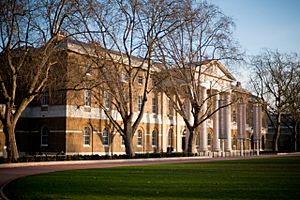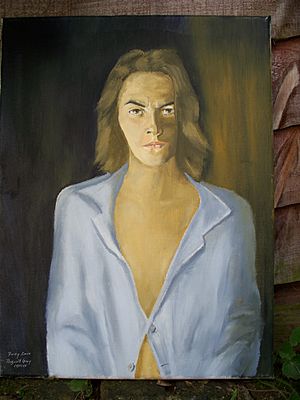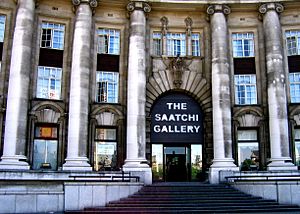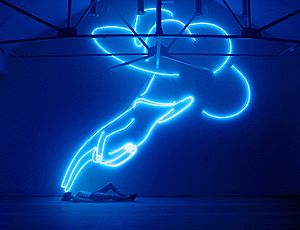Saatchi Gallery facts for kids
 |
|
| Lua error in Module:Location_map at line 420: attempt to index field 'wikibase' (a nil value). | |
| Established | 1985 |
|---|---|
| Location | Duke of York's Headquarters, King's Road London, SW3 United Kingdom |
| Visitors | 1,003,376 (2016) |
| Public transit access | |
The Saatchi Gallery is a famous gallery in London that shows contemporary art, which is art made by artists living today. It was opened in 1985 by Charles Saatchi and is now an independent charity.
The gallery became known for showing exciting new art. It started with American artists and a style called minimalism, which uses simple shapes and forms. Later, it became famous for showing a group of artists called the Young British Artists (YBAs), including Damien Hirst.
Over the years, the gallery has been in a few different places. It started in North London, moved to the South Bank near the River Thames, and is now in Chelsea. In 2019, the Saatchi Gallery became a registered charity. This means its main goal is to make art available for everyone to see and enjoy.
The gallery's mission is to support artists and help people understand and enjoy contemporary art. It puts on exhibitions that are interesting and relevant to today's world. It also has educational programs to help young people explore their creativity.
Contents
History of the Gallery
The First Gallery on Boundary Road
The Saatchi Gallery first opened in 1985 in a large, old paint factory. The first exhibitions showed art by famous American artists like Andy Warhol, who was a leader in pop art, and Donald Judd, a key figure in minimalist art.
The gallery continued to show important artists from America and Germany, like Anselm Kiefer and Richard Serra. Some of Richard Serra's sculptures were so huge that a nearby apartment had to be knocked down to make space for them!
In 1987, an exhibition called New York Art Now introduced British audiences to new American artists like Jeff Koons. The art in this show was a mix of minimalism and pop art, which inspired many young British artists.
The Young British Artists
In the early 1990s, Charles Saatchi made a big change. He sold many of his American artworks and started to buy art from a new generation of British artists. These artists became known as the Young British Artists or YBAs.
Many of these artists, like Damien Hirst, had already shown their work together in a famous 1988 exhibition called Freeze. Saatchi's support helped them become famous all over the world.
The first YBA show at the Saatchi Gallery was in 1992. One of the most talked-about pieces was a work by Damien Hirst that featured a real shark preserved in a glass tank. This artwork became a symbol of the YBA movement. Other famous YBAs shown at the gallery included Sarah Lucas, Gavin Turk, and Rachel Whiteread.
In 1997, the Royal Academy in London hosted a huge exhibition called Sensation, which showed 110 works by 42 artists from Saatchi's collection. The show was very popular but also caused a lot of debate about what can be considered art.
A New Home at County Hall
In 2003, the gallery moved to County Hall, a historic building on London's South Bank. The new space was even bigger, with 40,000 square feet (3,700 m2) for exhibitions. The opening show included a look back at the work of Damien Hirst and other YBAs like Tracey Emin and the Chapman brothers.
However, Hirst was not happy with the exhibition. He felt that one of his artworks, a Mini car he had decorated for charity, was not meant to be shown as a serious piece of art.
Sadly, in 2004, a fire at a storage warehouse destroyed many important artworks from the collection. This included Tracey Emin's famous tent piece and a well-known sculpture by the Chapman brothers.
After the fire, Saatchi began to sell some of his YBA art, including Damien Hirst's famous shark, which sold for nearly £7 million. He then changed his focus again, launching a series of exhibitions called The Triumph of Painting, which showed work by painters from Europe and America.
The gallery had to move again after a disagreement with the owners of County Hall.
The Current Gallery at Duke of York's HQ
In October 2008, the Saatchi Gallery opened in its current home at the Duke of York's Headquarters in Chelsea. This building is a beautiful, large space with 15 galleries for showing art.
The first exhibition in the new location was The Revolution Continues: New Art From China. It featured work by 24 young Chinese artists and was a huge success. Critics praised the show, saying it was one of the best exhibitions of modern Chinese art ever seen in the UK.
Since then, the gallery has hosted many popular shows. These include an exhibition about the ancient Egyptian king Tutankhamun and a show for recent art school graduates whose final-year shows were cancelled because of the pandemic.
Saatchi Online

In 2006, the gallery launched a website called Saatchi Online. It was a place where artists from all over the world could create their own page and show their work to a global audience. The website became very popular, with thousands of artists signing up.
The site allowed artists to sell their work directly to buyers. It also had features like an online magazine, chat forums, and competitions. It was a new way for artists to get noticed without needing to be in a physical gallery.
In 2014, Saatchi Online was sold and is now known as Saatchi Art. It continues to be an online marketplace for artists to sell their original artworks and prints.
The Gallery's Mission
The Saatchi Gallery's main goal is to show new and exciting contemporary art that people might not see in other big museums like the Tate Modern. The gallery wants to introduce people to the artists of today who could become the stars of tomorrow.
By offering free admission to all its exhibitions, the gallery aims to make art accessible to everyone, not just experts. It wants to be a place where anyone can come to see what is happening in the world of art right now.
See also
 In Spanish: Saatchi Gallery para niños
In Spanish: Saatchi Gallery para niños



